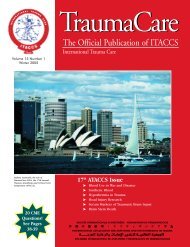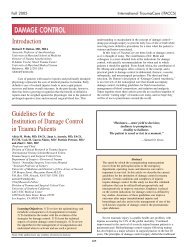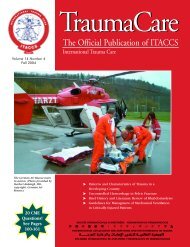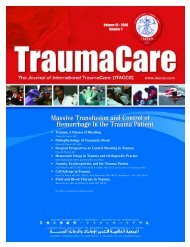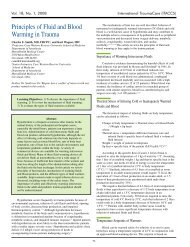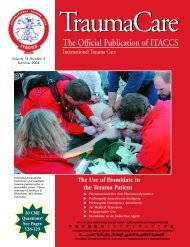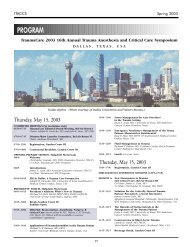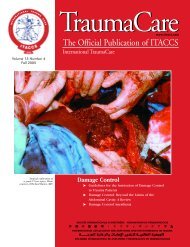The Official Publication of ITACCS - International Trauma ...
The Official Publication of ITACCS - International Trauma ...
The Official Publication of ITACCS - International Trauma ...
You also want an ePaper? Increase the reach of your titles
YUMPU automatically turns print PDFs into web optimized ePapers that Google loves.
<strong>ITACCS</strong> Spring 2003<br />
References<br />
1. Koenig KL, Schultz CH. Disaster medicine: advances in local catastrophic disaster<br />
response. Acad Emerg Med 1994; 1:133–6.<br />
2. Schultz CH, Koenig KL, Noji EK. A medical disaster response to reduce immediate<br />
mortality following an earthquake. N Engl J Med 1996; 334(7):438–44.<br />
3. Benson M, Koenig KL, Schultz CH. Disaster triage: START, then SAVE–a new method<br />
<strong>of</strong> dynamic triage for victims <strong>of</strong> a catastrophic earthquake. Prehosp Disaster Med<br />
1996; 11(2):117–24.<br />
4. Koenig KL, Dinerman N, Kuehl AE. Disaster nomenclature–a functional impact<br />
approach: the PICE system. Acad Emerg Med 1996; 3:723–7.<br />
5. Schultz CH, Koenig KL, Noji E. Disaster planning and response. In Marx J,<br />
Hockberger R, Walls R, eds. Rosen’s Emergency Medicine: Concepts and Clinical<br />
Practice, 5th edition. St. Louis, Mosby, 2002.<br />
Databases for Storing Prehospital and Intrahospital Data<br />
Peter A. Oakley, MA, FRCA, MRCGP<br />
Consultant in Anaesthesia and <strong>Trauma</strong>, North Staffordshire Hospital, Stoke-on-Trent,<br />
UK; Senior Research Fellow, Keele University<br />
Databases for Storing Pre-hospital and Intra-hospital Data<br />
Dr. Peter A. Oakley<br />
Consultant in Anaesthesia and <strong>Trauma</strong><br />
University Hospital <strong>of</strong> North Staffordshire<br />
Stoke-on-Trent, Staffordshire, UK<br />
Learning Objectives: To understand the changing requirements for data collection<br />
in trauma care and to appreciate the influences affecting data accuracy.<br />
In a cost-constrained, evidence-based, and digitally competent world, data is precious.<br />
We need it to justify our actions and to point out improvements or pitfalls in care. Its very<br />
necessity creates a tension between unbiased accuracy and the desire to bolster our own<br />
practice. <strong>The</strong> more we are judged on our performance as demonstrated by the data, the higher<br />
the stakes become and the greater the need for transparency. <strong>The</strong>se pressures are further<br />
confounded by the difficulty <strong>of</strong> recording real-time data in an emergency situation and the<br />
inherent uncertainty in the information at the time. Without cost constraints, we would<br />
employ extra scribes to record events while others deliver patient care or we would invest in<br />
labor-intensive media recordings with analytical replay to extract data.<br />
Despite these conflicting constraints, many worthy data systems have been developed<br />
and they have played a pivotal role in trauma care. In its heyday, the Major <strong>Trauma</strong> Outcome<br />
Study (MTOS) allowed an overall comparison <strong>of</strong> mortality in different centres, adjusting for<br />
the variation in anatomical injury and physiological response using the TRISS methodology.<br />
Database development was relatively naïve at the time, leading to data structures that were<br />
somewhat clumsy and were extended ‘by accretion’ as extra variables were added piecemeal<br />
to the whole. In addition, the early focus was on pre-hospital and emergency department<br />
care, neglecting the important contribution <strong>of</strong> definitive care and rehabilitation to outcome<br />
(measured in terms <strong>of</strong> morbidity and disability rather than just mortality).<br />
With the lessons we have learned and the seemingly limitless potential <strong>of</strong> new digital<br />
technology, we are developing new systems. We demand standardization and are keen to<br />
agree on universal data sets. Our greed for completeness haunts us as the list <strong>of</strong> variables<br />
grows ever larger and the problems <strong>of</strong> error, omission, and ‘noise’ remain with us.<br />
Commercial systems such as Collector(, while not inexpensive, have allowed pr<strong>of</strong>essional<br />
s<strong>of</strong>tware developers to enhance the way in which the data is handled. Over 200 centers<br />
worldwide have signed up to Collector’s flexible system. <strong>The</strong> American College <strong>of</strong> Surgeons<br />
has developed its own system, <strong>of</strong>fering the ability to import data from other commercial systems<br />
(including Collector). Its NTRACS( trauma registry, launched in 1992, and the associated<br />
national trauma data bank NTDB( <strong>of</strong>fer national recognition, although only 20-25% <strong>of</strong><br />
Level I-II trauma centers currently subscribe.<br />
In Europe, the demand for unity and standardization is equally strong. After an international<br />
workshop coordinated by the <strong>Trauma</strong> Research and Audit Network (TARN), a<br />
European consensus on the minimum data set for trauma is being established, using the<br />
Delphi technique. TARN, the surviving UK sister <strong>of</strong> MTOS, has commissioned a new webbased<br />
data management system to facilitate remote input <strong>of</strong> and access to data. Although it<br />
incorporates new thinking on the generic nature <strong>of</strong> trauma data as the patient moves from<br />
one location to another (e.g. scene to ER to OR to ICU), other developments await the anticipated<br />
technological surge to allow real-time observations and decision-making to be incorporated<br />
into our trauma data systems.<br />
Bibliography<br />
American College <strong>of</strong> Surgeons <strong>Trauma</strong> Registry: http://www.facs.org/dept/trauma.<br />
Dick WF, Baskett PJ, Grande C, et al. Recommendations for uniform reporting <strong>of</strong> data<br />
following major trauma – the Utstein style. Br J Anaesth 2000; 84:818–9.<br />
<strong>Trauma</strong> Research and Audit Network: http://www.tarn.ac.uk.<br />
Wynn A, Wise M, Wright MJ, et al. Accuracy <strong>of</strong> administrative and trauma registry databases.<br />
J <strong>Trauma</strong> 2001; 51:464–8.<br />
— Session C —<br />
Scientific Free Paper Presentations<br />
Moderators: Enrico M. Camporesi, MD, Syracuse, New York; Adolph H. Giesecke, MD,<br />
Dallas, Texas; John K. Stene, MD, PhD, Hershey, Pennsylvania, USA<br />
Battle Field Anaesthesia: How Different Is It?<br />
Dr. Ankit Sarin and Major Manish Mehrotra<br />
<strong>The</strong> provision <strong>of</strong> anesthesia and critical care is always a big challenge in trauma victims.<br />
It, however, becomes broadly redefined when working in field conditions due to inadequate<br />
logistic support and non-availability <strong>of</strong> optimal working conditions. This is exemplified while<br />
working in a combat zone trauma center.<br />
Military anesthesia has been instrumental in providing care to the wounded since the<br />
discovery <strong>of</strong> anesthesia in 1846 and has made significant progress over the years. Each war<br />
and conflict has required anesthesiologists working in service hospitals to adapt to new challenges<br />
in different environments. This paper provides an insight into the working <strong>of</strong> a forward<br />
military trauma care center located in insurgency-rife Jammu and Kashmir sector. This<br />
part <strong>of</strong> India is at high altitude with extreme cold climate and high wind velocity. Besides the<br />
shelling, altitude, and cold, the area is heavily mined. <strong>The</strong> steep gradient and loose rocky surface<br />
make it prime avalanche territory.<br />
<strong>The</strong> team comprises a single anesthesiologist and a surgeon with necessary ancillary<br />
staff. <strong>The</strong> main operation theatre is inside an underground bunker. We managed 767 casualties<br />
over a period <strong>of</strong> two and a half years (November 1999 to June 2002), out <strong>of</strong> which 587<br />
patients underwent surgery. This included 209 splinter injuries, 191 gunshot wounds, 118<br />
landmine injuries, and 69 grenade injuries.<br />
A standardized protocol using the basics <strong>of</strong> trauma anesthesia was followed. Adequate<br />
wound treatment was given prime importance. Radical primary wound debridement and foreign<br />
body removal accounted for three fourths <strong>of</strong> the procedures. <strong>The</strong> choice <strong>of</strong> anesthesia<br />
was dependent on the site <strong>of</strong> involvement. DA was used for all 23% <strong>of</strong> cases and GA for 19%.<br />
<strong>The</strong> remaining cases were done under regional block anesthesia.<br />
Military experience has shown that the presence <strong>of</strong> expert care in the vicinity <strong>of</strong> a forward<br />
post is a very big moral booster for troops employed in warfare. Prompt optimal care<br />
gives the trauma patient a chance to return to functional life. <strong>The</strong> future challenge for anesthesiologists<br />
involved in trauma care in an advance field surgical unit is to provide tertiary<br />
level care within the available resources and to minimize morbidity and mortality.<br />
Cervical Spine Management in Unconscious Adult <strong>Trauma</strong> Patients: Survey <strong>of</strong><br />
Practice in UK Specialist Centres<br />
Dr. Phil Jones, Mr. John Wadley, Dr. Marie Healy<br />
Royal London Hospital, London, United Kingdom<br />
Learning Objective: To determine how the cervical spine is assessed before discontinuation<br />
<strong>of</strong> immobilisation in unconscious adult trauma patients in UK neurosurgical<br />
centres.<br />
Purpose <strong>of</strong> study: a) to establish if each unit had a written protocol or guidelines to<br />
screen for cervical spine injury, b) to determine the radiological screening tests used routinely<br />
in all unconscious patients, and c) to ascertain whether cervical spine immobilisation<br />
was normally continued until the patient regained consciousness and could be examined<br />
clinically.<br />
Method Used. A postal questionnaire was sent to all neurosurgical centres in the United<br />
Kingdom. Follow-up telephone contact was made if a reply was not received within 6 weeks.<br />
Results. 27 <strong>of</strong> 32 centres responded (84% response rate). <strong>The</strong> following results refer<br />
to the units from whom replies were received: 9% had written guidelines for the radiological<br />
screening tests used routinely in unconscious adults, 6% had a written policy for discontinuing<br />
immobilization, 56% <strong>of</strong> centres used fewer than three plain radiographs (over half <strong>of</strong><br />
these centres did not use computed tomography [CT] routinely). CT scanning was used in<br />
10 centres (37%). Two centres (7%) used dynamic fluoroscopy routinely. One centre used<br />
magnetic resonance imaging (MRI) routinely.<br />
If all radiological investigations were normal, 44% <strong>of</strong> centres discontinued immobilisation<br />
before the patient was awake and could be assessed clinically.<br />
Seven centres (26%) had experience in dynamic flexion-extension fluoroscopy. Three<br />
<strong>of</strong> these believed it was unsafe.<br />
Conclusion. <strong>The</strong>re is little consistency in how the cervical spine is assessed before<br />
the removal <strong>of</strong> immobilisation precautions in UK neurosurgical centres. Although the use <strong>of</strong><br />
plain radiography is ubiquitous, there is wide variation in the number <strong>of</strong> films taken. Routine<br />
use <strong>of</strong> CT is surprisingly low for specialist centres dealing with unconscious trauma victims.<br />
Clinicians in these centres have little experience, and less faith, in the safety <strong>of</strong> dynamic fluoroscopy.<br />
Clinically Relevant Hyperventilation <strong>of</strong> First Aid Providers<br />
Results from Artificial Ventilation<br />
B. Kleine-Weischede, T. Piepho, MD, C. Jaenig, B. B. Wolcke, MD, A. R. Thierbach, MD<br />
Clinic <strong>of</strong> Anesthesiology, Johannes Gutenberg-University, Mainz, Germany<br />
Learning Objective: To investigate the hypothesis that rescuer ventilating an apneic<br />
victim during basic life support (BLS) performing mouth-to-mouth or mouth-to-nose ventilation<br />
suffers from clinically relevant and statistically significant hyperventilation.<br />
Purpose <strong>of</strong> Study. <strong>The</strong> “Guidelines 2000 for Cardiopulmonary Resuscitation and<br />
Emergency Cardiovascular Care–<strong>International</strong> Consensus on Science” recommend a ventilation<br />
volume <strong>of</strong> 10 mL/kg body weight (equivalent to a tidal volume <strong>of</strong> 700 to 1000 mL) without<br />
the use <strong>of</strong> supplemental oxygen in adults during isolated respiratory arrest and two-rescuer<br />
cardiopulmonary resuscitation (CPR). 1 Additionally, a deep breath is recommended<br />
before each ventilation to increase the end-expiratory oxygen concentration <strong>of</strong> the air<br />
exhaled by the first aid provider.<br />
Methods. To investigate the effects <strong>of</strong> these recommendations in healthy volunteers,<br />
test persons were asked to perform isolated artificial ventilation and two-rescuer CPR in a<br />
lung model connected with a BLS mannequin. <strong>The</strong> tidal volume was fixed to 800 mL. <strong>The</strong><br />
breathing rate was set to 12/min for isolated respiratory arrest. In the two-rescuer cardiopulmonary<br />
resuscitation model, it depended primarily on the rate <strong>of</strong> chest compressions (set to<br />
100/min). <strong>The</strong>refore, a breathing rate between 8 and 9/min could be achieved by the test persons.<br />
End-tidal carbon dioxide, oxygen saturation (measured by pulse oximetry), and heart<br />
rate were recorded continuously. Capillary blood gas samples (including capCO 2 ) were collected<br />
before and after the ventilation periods.<br />
Results. Clinically and statistically significant hyperventilation results in first aid<br />
providers performing artificial ventilation during isolated respiratory arrest 2 and two-rescuer<br />
CPR according to the Guidelines 2000. <strong>The</strong> ventilation was associated with a significant<br />
decrease in capillary and end-expiratory carbon dioxide pressure (p




